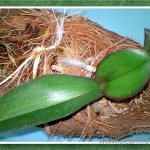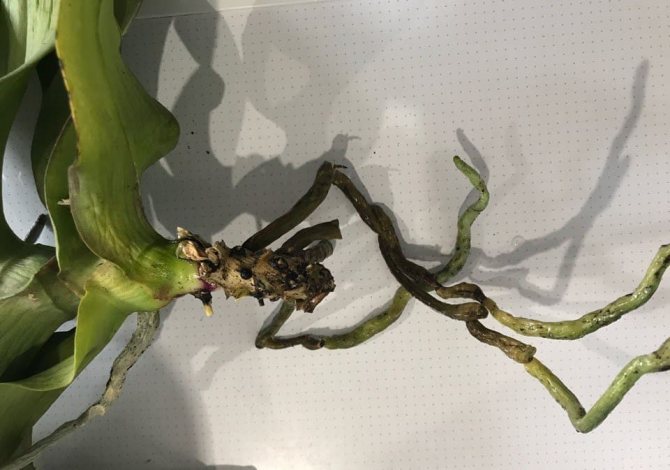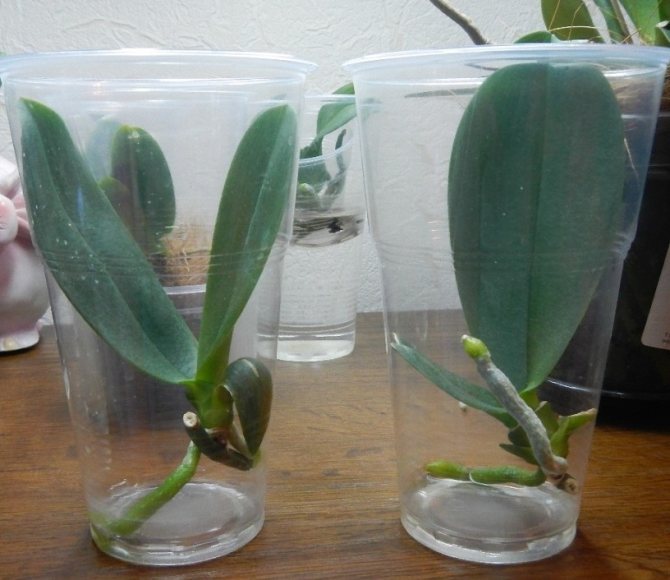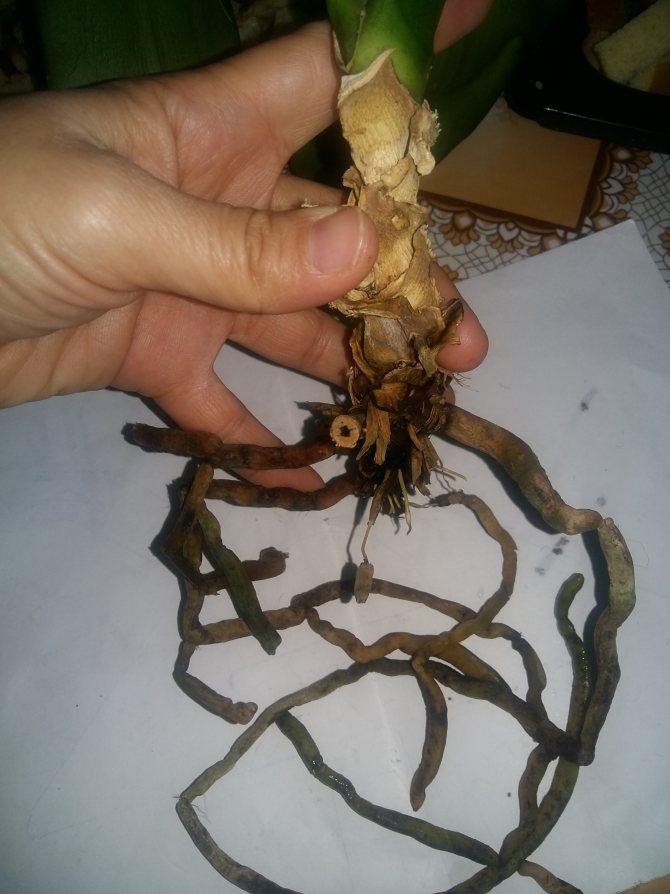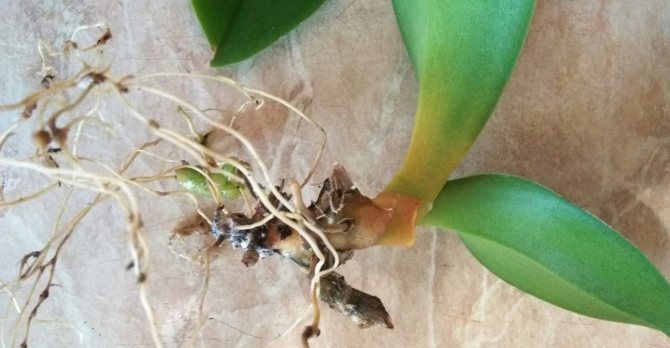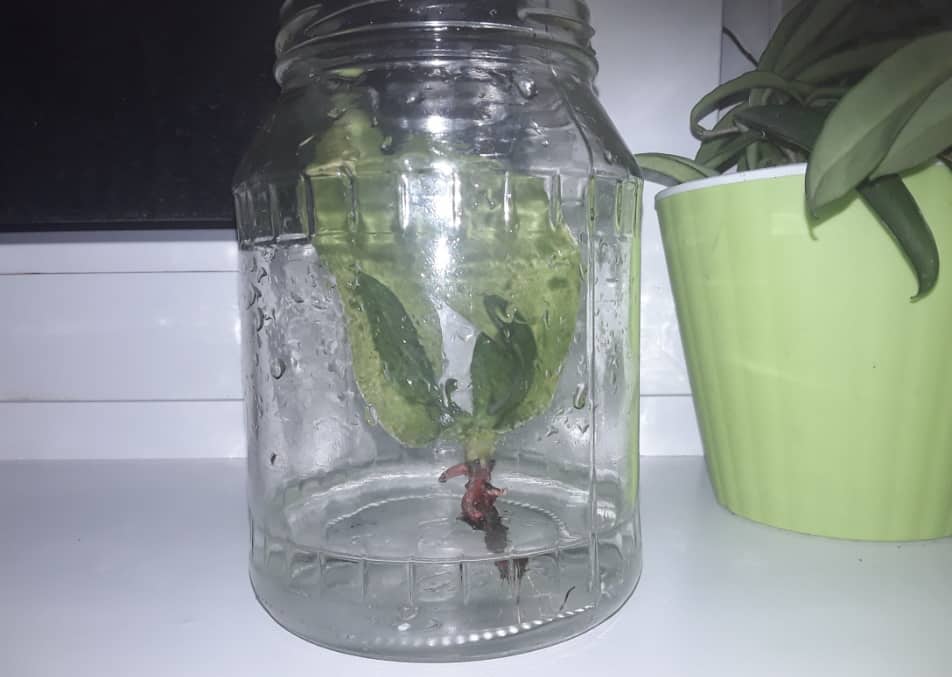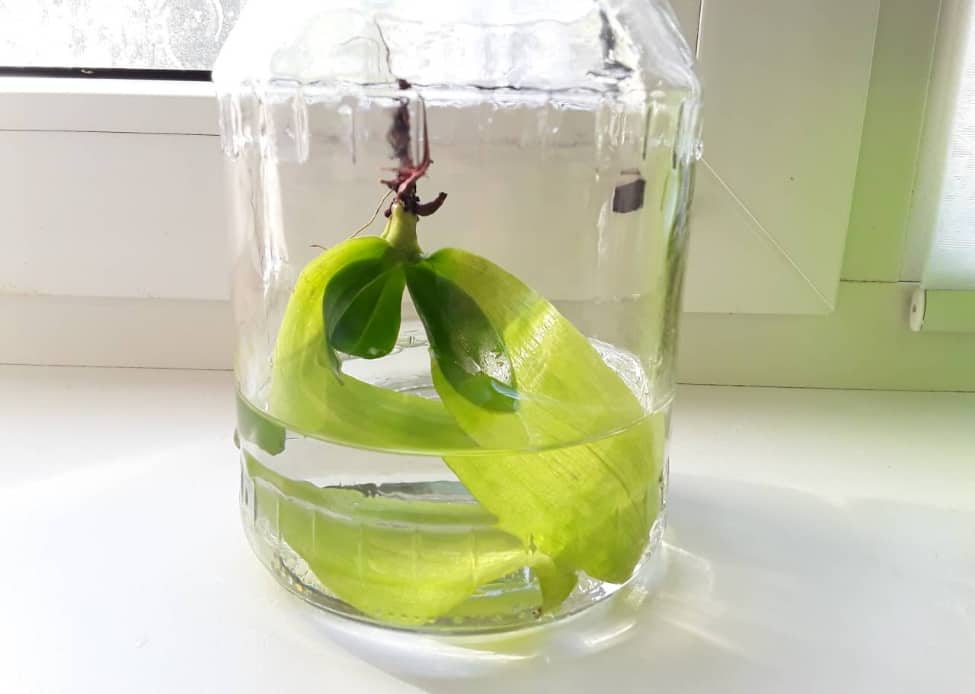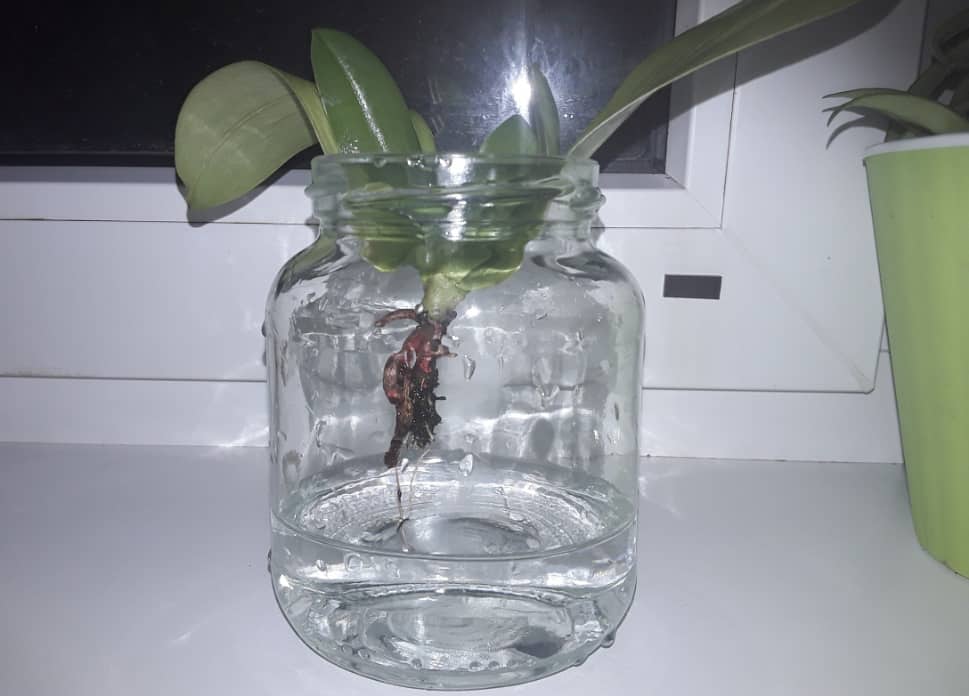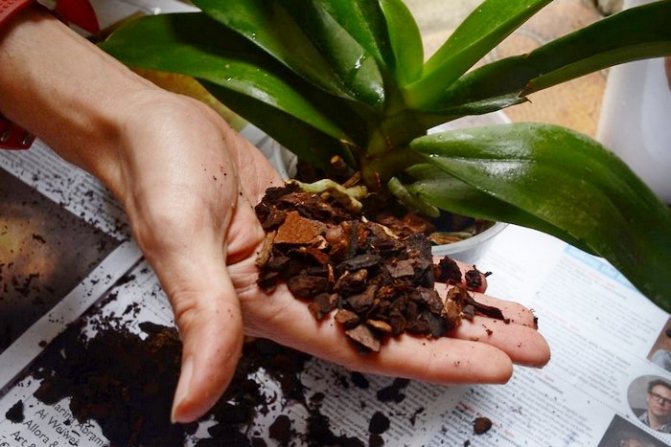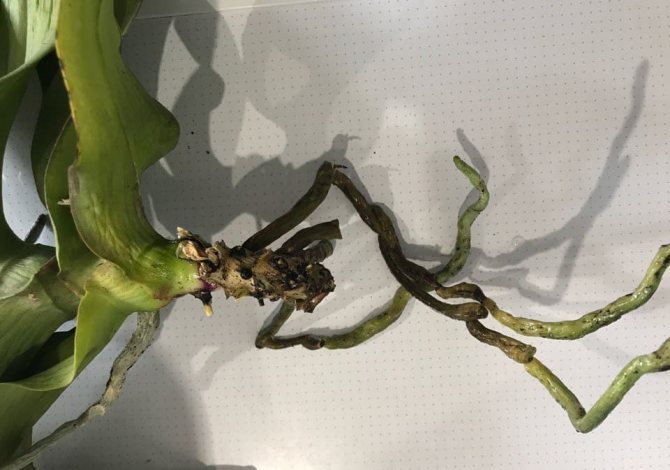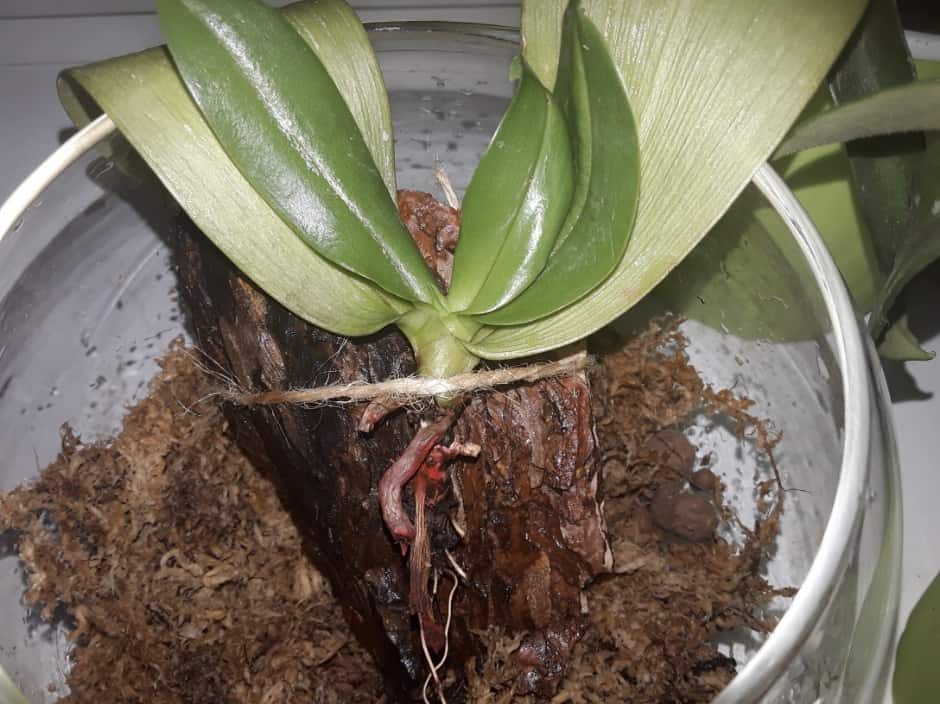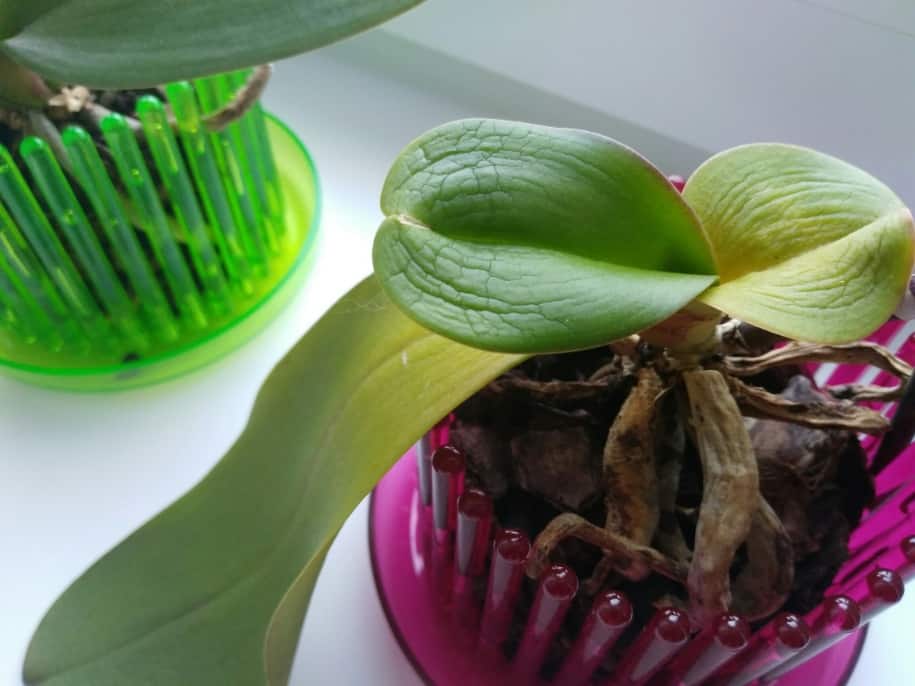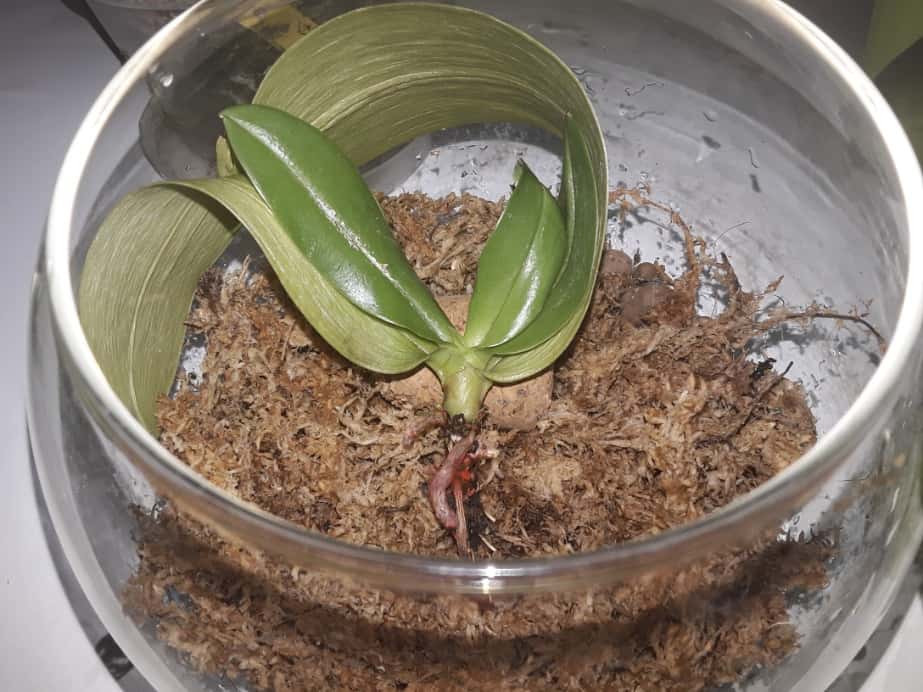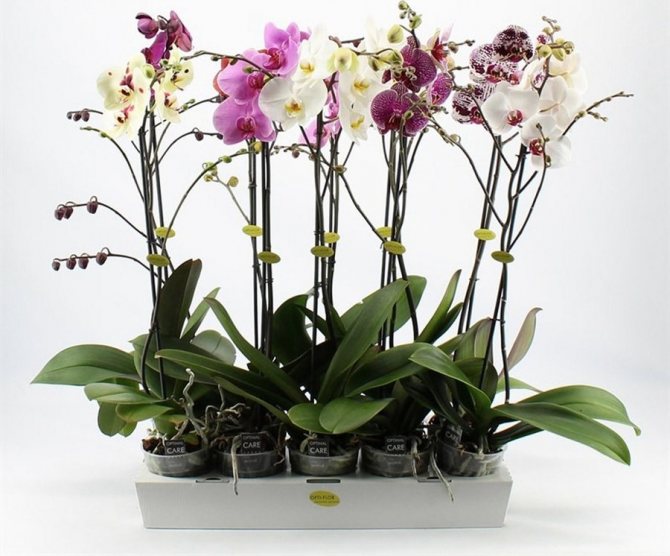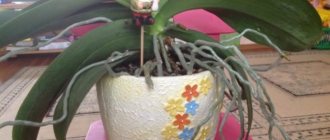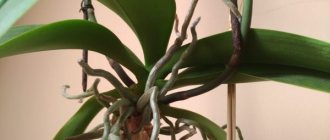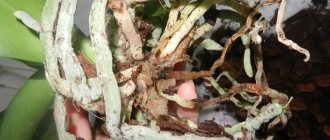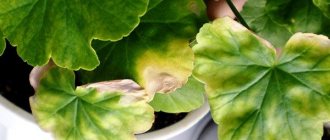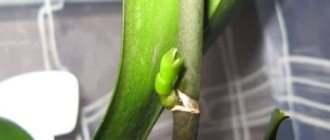Do you have a young plant or several on phalaenopsis and you do not know what to do next?
In order for the separation and transplantation of a young orchid to be successful, you need to know how to grow roots in children of the phalaenopsis orchid.
With a favorable set of circumstances, they can appear on their own, but often the roots have to grow.
The first question is when guests see the children of this unusual plant, how they can be obtained.
This can be done in two ways:
- Natural (after the end of the flowering of the phalaenopsis, we cut off the yellowed part of the peduncle). After that, lateral peduncles or children may appear from the sleeping buds of the remaining peduncle.
- The second method is the artificial awakening of dormant kidneys using cytokinin paste (I described this method in detail here).
The newly formed plant cannot be separated from the adult month 3 - 4 until it has 3 - 4 leaves and rootlets 2-3 cm long. But it so happens that the leaves grow, but the roots of the young plant still have no and no ...
How to separate the baby
On the home phalaenopsis orchid, babies were formed. How to properly separate the babies from the mother branch?
A young plant is separated from the maternal peduncle with a scalpel.
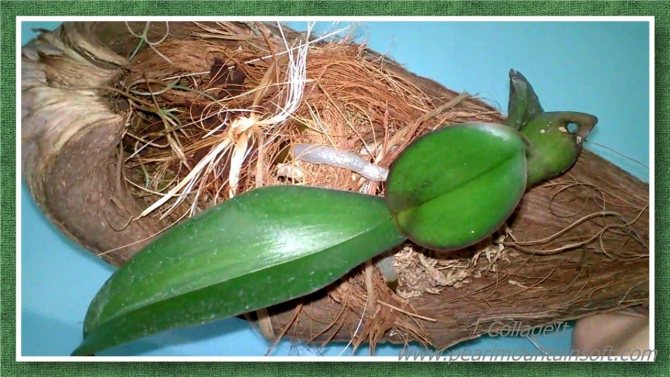
Fig. 1 The baby is separated from the main plant along with a piece of peduncle.
The seedling material separated from the parent plant has no roots. In order for the baby to start and turn into a full-fledged flower, it is necessary to create conditions that stimulate the formation of the root system.
Possible problems
The difficulties that may arise during the process of growing roots in a child are not so many. The very first and perhaps the only thing that may alert you - yellowing or drying of the appendix itself.
In this case, do not leave everything to chance and constantly monitor the condition of the baby. If it does not improve, change the containment conditions. First of all, add light and feeding, and also keep in mind that the shoot feels good when the air temperature is elevated in the room. Therefore, the house should be constantly warm.
So, we told what a baby is in an orchid and why the plant itself needs it, as well as a florist. We talked about how to help the scion grow a root system for normal functioning. We hope that the information provided in the article will be useful for both an experienced gardener and a beginner.
Growing roots in a greenhouse
The roots begin to develop actively if the phalaenopsis has enough moisture and the amount of light. A suitable microclimate for a plant can be created by building a greenhouse for it from a plastic bottle.
Necessary materials
Prepare the necessary materials in advance:
- plastic cup;
- small pebbles or clay shards;
- moss;
- plastic bottle;
- plastic bag.
Step-by-step instruction
We do a mini-greenhouse like this:
- in the bottom of the plastic cup, several holes are pierced with an awl to drain excess liquid;
- pebbles are laid out on the bottom for drainage;
- the next layer is moss;
- closer to the top of the glass, four holes are made against each other with a screwdriver.
- 2 sticks are passed through the upper holes, they will be a support for the flower;
- the shoot is placed so that the stem passes between the supports and is sunk a few centimeters in the moss;
- the plant is covered with a cut-off bottle;
- in this position, the flower remains until the moment until it drops the roots.
You can transplant the orchid into a pot when roots have formed. Children who have reached a height of 7-8 cm are suitable for growing roots.
Rooting on the block
This rooting method requires a large, solid piece of pine bark. Procedure:
- Bark, independently harvested in the forest, boil for an hour and cool to room temperature. Soak a dry block purchased in a specialized store for several days in water.
- Treat the root collar of the orchid with a solution of succinic acid (half a tablet for 50 g of water) or vitamin B₁.
- Fix the prepared plant on a wet block so that the base touches the surface of the bark.
- Put wet moss or vermiculite on the bottom of the container.
- Place the block with the plant in the vessel.
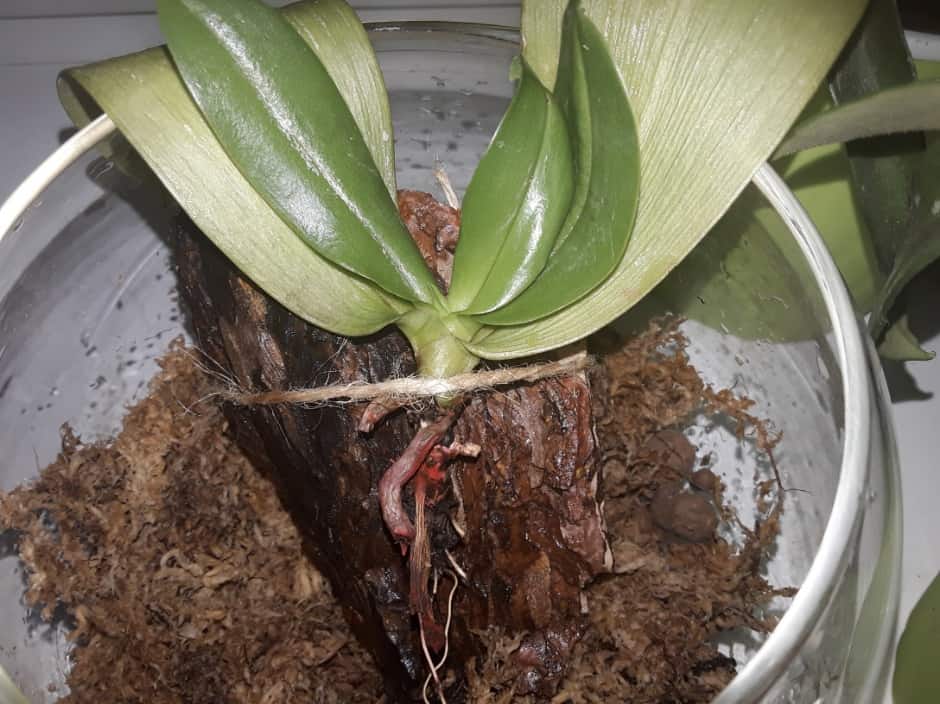

The neck of the orchid is fixed on a large piece of wet pine bark. The process of forcing the roots on the block takes about 3 months on average. After this period, the bark will have to be re-soaked. After the roots appear, the plant is transplanted into the usual substrate.
Growing roots in orchids in foam
Growing roots in foam is a rare but effective method. They do it like this:
- a recess is made in a small piece of polystyrene for the baby of the plant;
- the baby is placed in the hole and fixed in any convenient way in an upright position;
- a foam container, along with a young plant, is placed in a deep bowl of water,
- a bowl with an orchid is covered with plexiglass on top;
- water is constantly poured into the container, this is necessary so that the air in the mini-greenhouse is saturated with moisture;
After a while, the little phalaenopsis will have roots. After that, the baby needs to be placed in moss and bark.
Important... Any manipulation aimed at stimulating the growth of roots in orchids is based on the creation of an artificial microclimate close to the natural conditions for the existence of these plants.
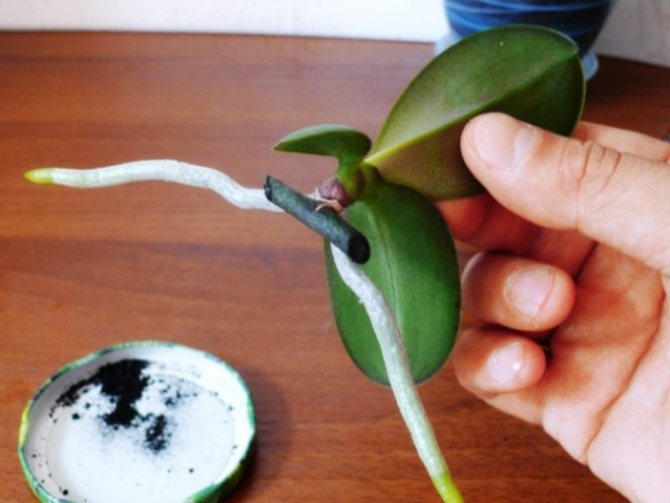

Fig. 2. You can grow the roots of your baby in a coconut shell.
Is it possible to speed up the resuscitation process?
Plant rooting can be accelerated by feeding:
- Fertilizers for orchids with a nitrogen content of not more than 14% are added two to three times a month. Iron chelate, necessary for a weakened flower, can be added frequently, every two to three days. Iron overdose is impossible. Growth regulators such as Zircon or Epin are used no more than once a month.
- Succinic acid stimulates the growth of roots well. For a solution per liter of boiled water, take 4 tablets. Both the leaves and roots are wiped with a cotton pad or cloth dipped in a solution. Wipe the leaves so that moisture does not accumulate in the axils of the leaf plates.
- Additionally, the leaves can be wiped with an aqueous solution of vitamin B. This is done in the evening to avoid the sun's rays, destroying the effect of feeding.
- Sometimes it is recommended to wipe the leaves with a solution of honey or sugar, but in comparison with succinic acid, this method is less effective. If it is possible to use only it, take a teaspoon of sugar or honey per liter of water.
How to root baby
A plant with overgrown roots can be planted in a pot. A young plant cannot be planted in a hanging planter; a pot or peat glass is well suited for it. The container is filled with a soil mixture intended for orchids. The substrate can be made on your own or you can buy ready-made soil in a special store.
“After planting, the plants are not watered for 5-7 days, the greenhouse is not ventilated, but the air humidity in it is increased to 90-95% by spraying racks, paths, walls. After a week, the plants are moderately watered with water, in addition, on hot days they are sprayed 2-3 times. It is not recommended to cover boxes and bowls with glass, as excess moisture accumulates, which contributes to the formation of microscopic fungi that cause the death of plants. The substrate in which the rooting of plants takes place must be maintained in a state of constant and uniform moisture; neither drying out nor excessive moisture must be allowed. In the first time after planting / 2-3 weeks / it is necessary to especially protect the plants from direct rays, for this, paper is laid under the shade. "
Cherevchenko, Tatiana Mikhailovna. Academic degree: Doctor of Biological Sciences
Orchid potting mix consists of:
- moss,
- chopped pine bark;
- birch coal;
- rotted foliage.
Advice... It is very convenient to plant seedlings in peat cups or pots.
How to transplant a young orchid
Grown up samples are transferred to a regular pot and hung in a flowerpot. It will not be possible to grow small plants in a suspended state, they will not yet be able to hold the trunk with leaves at the expense of the root system.
If the phalaenopsis baby was planted for rooting in a peat container, then transplanting a flower is reduced to transferring the pot along with its contents into a larger container (clay pot). The gaps between the edges of the small peat pot and the outer container are covered with soil mixture for orchid plants.
An orchid that grew in a plastic or clay container is transferred from a small pot very carefully so as not to damage the roots. The soil mixture is poured gradually. The layer of soil covering the roots must not be tamped.
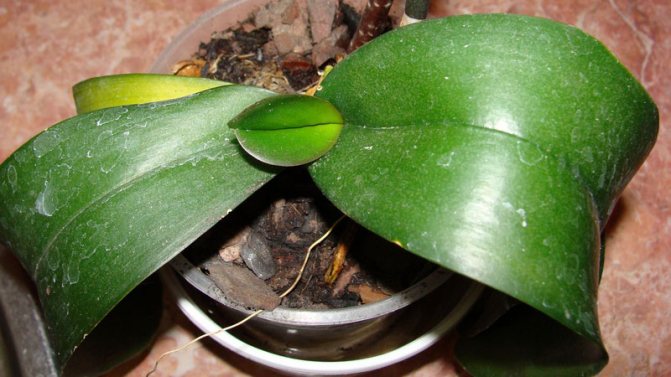

Fig. 3 A well-rooted orchid will release new leaves.
The reasons for their death
The root system of the orchid may die due to the old age of the plant, in this case it is no longer possible to help it. In all other cases, care errors will be the cause.
Overflow
Orchids are moisture-loving plants, but an excess of water is dangerous for them. In a constantly moist substrate, the covering tissue on the roots - velamen - begins to rot. With periodic overflows, the roots can rot slowly, in a constantly humid environment - faster. As a result, if you do not take action, the decayed root system will disappear. At the same time, the leaves of the plant will also partly fall off, partly they will look sick.
Important! Overflow is especially dangerous in poor lighting conditions. An orchid that does not receive the required amount of light slows down the growth processes inside itself and stops absorbing moisture.
Drought
Dangerous for phalaenopsis and lack of moisture. Prolonged lack of water will lead to the fact that the roots will gradually dry out and will not be able to recover with normal watering. Without irreversible consequences for the root system, an orchid can spend one and a half to two weeks without water.
Care
Caring for a young plant is almost no different from the usual care for adult phalaenopsis. For young rooted orchid babies, a little agent is added to the water that stimulates the active growth of plants.
Important... The plant needs regular watering. The orchid is watered using the bottom watering method, adding water in small portions to the pan. If the flower is poured from above, the soil will lose the air permeability necessary for the flower.
The air in the room where the tropical flower grows should be between 21 and 25 degrees. At temperatures below + 18, watering of orchids is suspended and the first thing to do is warm up the room, creating acceptable conditions.
Phalaenopsis do not like:
- wet swampy ground;
- direct sunlight;
- shading;
- the air temperature is below +18.
Why might this situation arise?
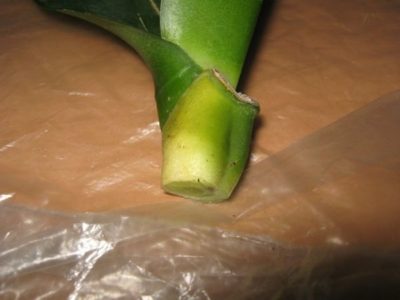

Too much watering. The most common cause of root rot. In conditions of constant humidity and poor ventilation, velamen - the tissue that covers the roots - begins to rot and over time this process spreads to the entire root system.- Lack of lighting. The orchid needs light for photosynthesis, without it the flower cannot form new cells, which means it stops developing, almost stops absorbing moisture and its roots begin to die.
- Hypothermia. If the temperature drops, the process of assimilating moisture from the substrate is disrupted, due to which the flower receives a cold burn and the root cells die.
- Chemical burn. Too strong a concentration of fertilizer, watering with fertilizer on dry soil and too frequent fertilizing can burn the delicate root system.
- Diseases. If the soil of the orchid was first dried out, and then it was flooded, an infection may occur, and at first the leaves of the plant will become lethargic, and later the death of the roots will begin.
- Unsuitable substrate. In no case should an orchid be grown in ordinary soil - in it the roots will rot due to lack of air. Hydrogel or sphagnum as the main substrate can also only harm the root system of the plant if watering is incorrectly calculated.
- Lack of moisture and heat. This dries up the roots of the plant.
- Hard and saline water. Such water cannot be used for irrigation, it has a bad effect on the general condition of the phalaenopsis and on its root system in particular.
Top dressing
Young plants should be well sprayed during the period of growing roots and rooting with solutions of fertilizers and growth accelerators. For these purposes, you can purchase:
- Agrecol with Vitamin C is a liquid concentrate. It dissolves well in water. Suitable for use as a growth stimulant.
- "Brexil Combi" - the product contains all types of trace elements necessary for orchids during the period of active growth. Spraying with the use of the drug is carried out no more than 1 time in 14 days.
Table No. 1. For potted adolescents and adult flowers, you can apply fertilizer in sticks.
Common mistakes
Novice flower growers believe that fertilizing at any time and in any amount has a positive effect on the growth of an orchid. In fact, food for a flower must be brought in according to certain rules. Excessive amounts of trace elements can be harmful to the plant.


Table No. 2.
Root top dressing is carried out taking into account the acidity level of the soil.
Myth 1. The plant with children must be completely sprayed with stimulating drugs.
In fact, only the leaves are sprayed with nutrient solutions, it is impossible for fertilizers to fall on the peduncles.
Myth 2. Stimulating top dressing will not damage the plant at a temperature of + 18 and even help to improve its condition.
Do not spray the plant with stimulating compounds at low temperatures. Top dressing is carried out in a warm room, where there are no drafts.
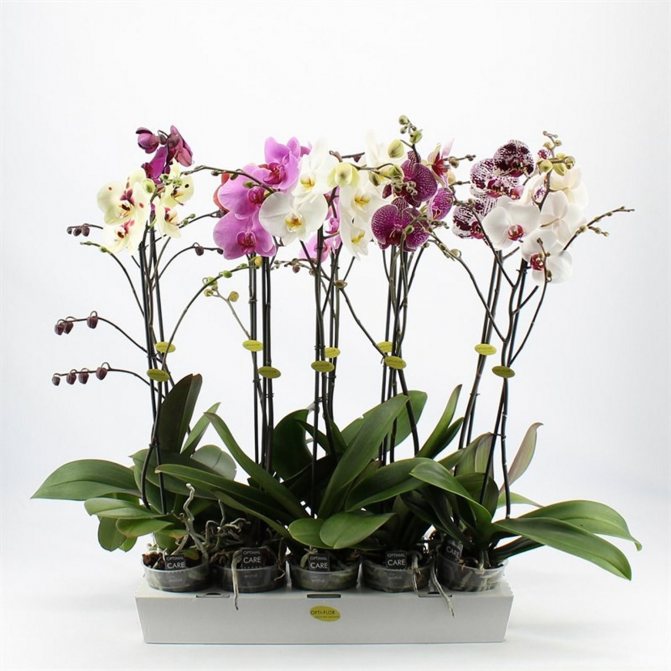

Fig. 4 Phalaenopsis grow well and bloom in warm rooms. For active growth, the flower needs diffused light.
Is it possible to save the culture and build up the root system?
Even if the roots of the phalaenopsis are completely dead, the plant itself can still be saved:
- The first step is to remove any dry, sore, or decaying areas. For this, the root system is washed in warm water, not higher than 30 degrees. A fungicide can be added to the water to prevent possible spread of infection.
- Then, with a sharp knife, remove all rotten areas, so that only living roots remain. Sections are disinfected by sprinkling with powdered activated carbon. It is permissible to use cinnamon. Important! Do not use alcohol-based preparations to disinfect the sections; they will burn the roots.
- The treated plant is left to dry in a warm place for no more than a day.
Rubric: "Question - answer"
Question one.How long should a baby orchid be kept in a greenhouse? Can a plastic bag be used together with plexiglass?
Answer... The flower is kept covered in a greenhouse until at least two new leaves grow on it. The baby grows to its normal size in about 1 year. All this time it is better to keep it covered. The greenhouse should be such that the leaves of the grown orchid do not touch the plastic walls. For this purpose, you can take a cut plastic five-liter bottle and close it on top with plastic wrap.
Question 2. The baby from the moment of separation from the mother plant is in the greenhouse. I spray it regularly. Slightly 1 root has grown. The lower leaves remain soft and wrinkled. There are no new leaves and roots. What to do, how to help an orchid?
Answer... You don't need to do anything. A good sign that a root has begun to grow. The lower leaves may not recover even in the greenhouse. Due to the nutrients accumulated in them, new leaves will begin to grow. To make the plant feel better, you can add growth stimulants to the spray water.
The main mistakes when building
How to take a shoot from an orchid: transplant options and examples at home
The extension of roots does not do without errors, which can sometimes cause the final death of a flower. It is worth paying attention to common situations and then the wilting plant will regain its blooming appearance.
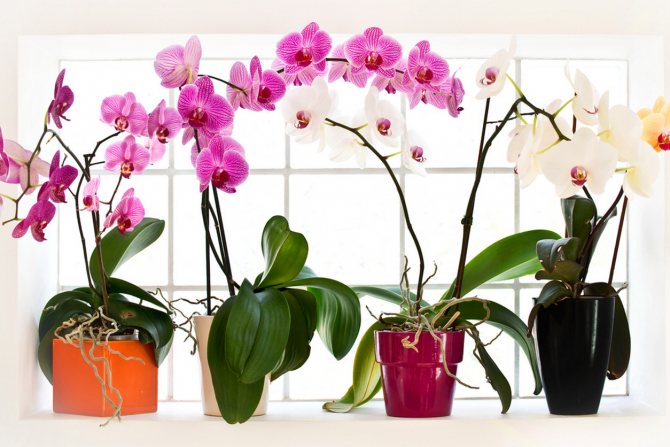

With the right approach, you can turn a withering plant into a blooming orchid.
Lighting
For maximum comfort, orchids should be placed on the north side. You can arrange a flower on the windowsill on the other side, but it is the north that is preferable. It is important to monitor the condition of the plant during the warmer months to avoid damaging sensitive leaves.
Transfer
Plant transplanting is a last resort and should not be used unnecessarily. If a change of soil is unavoidable, it is necessary to carefully process the roots and remove the damaged processes. Healthy shoots are treated with activated charcoal before planting in a new pot.
Humidity
It must be remembered that the orchid loves high humidity and functions normally only at an indicator of 50 percent. Additional ways to increase humidity levels should not be neglected.
Orchid is a capricious and fastidious flower, but this will not prevent a loving florist from growing its roots and giving the plant new life. The result will not be long in coming, but it is important not only to be patient, but also to follow all the tips and instructions. Do not forget that you can save the plant even in the most neglected case.

